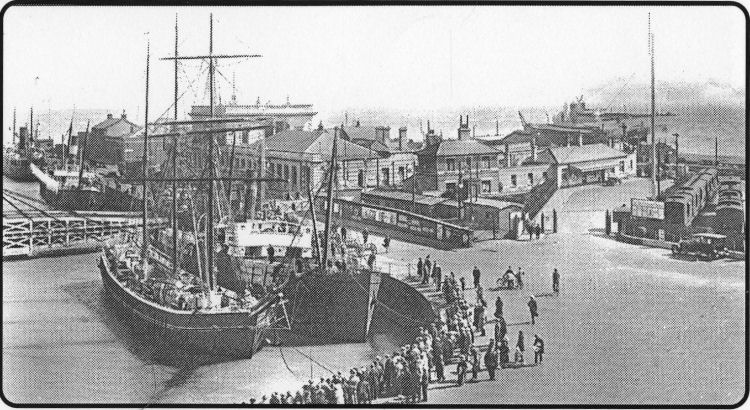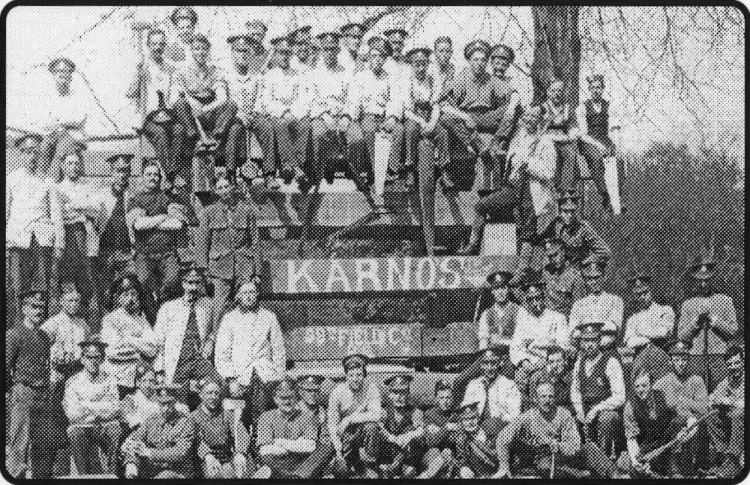
Published 26 October 2000
We told you!
RECENT scares over the dangerous pipe bombs unearthed at Hawkinge airfield
on what is now a housing estate - how do they get consent to develop such
historic and greenfield sites in the countryside? - prompted local history
enthusiast Derrick Lawson, of Lynwood, Folkestone, to write to me.
death,” says Derrick.
“We visited him on one occasion during the Second World War, in 1941, and he
told us of the bombs that the Germans dropped “that never exploded” - this
was common knowledge at the time and the Air Ministry was informed about
Fred Karno's Army? Nicknamed The Knuts, half these men of the 99th Field
Regt RE who served on the Somme in the First War came from Folkestone.
the ‘dud’ bombs that had fallen there,” he said.
“But they didn’t seem to want to know.
“These reports were just ignored.
“My uncle told me he saw several ‘sticks’ of bombs dropped into the soft
ground and those bombs just disappeared!
“He said there was a constant fear among the villagers of these bombs going
off at that time.”
Well, hopefully these were found when bomb disposal squads carried out
sweeps of the area on more than one occasion.
But now the defensive pipe bombs have been unearthed and dealt with in such
a dramatic fashion, with homes evacuated and so on, one can’t help wonder if
that really is the end of the matter.
Incidentally among some interesting family pictures Derrick brought into the
office was one of Fred (?) Karno’s army, nicknamed The Knuts, of the 99th
Field Company, Royal Engineers, who fought on the
He recalls how his late father took him to visit his uncle Percy Scowen who
had worked at the aerodrome since he was 16 until he retired.
“My Uncle was a chargehand fitter and an electrician and also lived in an
Air Ministry house near the aerodrome until his
JANET Adamson at Folkestone Library Heritage Room tells me that if any
readers wish to taste the sensation of a ride in one of the cars on the old
Switchback, featured in Memories recently, there is a film of Folkestone
that can be seen in the Museum at Grace Hill library, on the first floor,
which includes a unique, early film of a ride on the rollercoaster in 1904!
And admission is free between 9.30 and 5pm, Monday to Saturday! The film
shows many other scenes in old Folkestone, the Leas, a congregation in their
Sunday best at the parish church.....not to
mention local street scenes, including some taken in Sandgate Road and
Guildhall Street.
A DIFFICULT quest is being undertaken by family history researcher Mrs Pam
Dray, of Archer Road, Folkestone (01303 252901.) She read about a Corporal
Dray of the East Kent Regiment serving in the Boer War in South Africa. He
was acting as a cook at Chievley Camp and wrote home about his personal
experience of a fierce battle known as the Battle of Colenso in 1899. He
said losses in killed, wounded and prisoners
were 1,147, very heavy indeed.
Mrs Dray is wondering if he was John Dray, her husband’s 5th
great-grandfather’s son, and whether he ever returned from the South African
war.
Great-grandfather James Dray, of Albert Lane, Hythe, had seven sons who
served in the First World War. Six returned home safely. Mr Dray received a
special letter from the King, in 1915, saying what a fine example the family
was to the nation. He used to run a fish and chip shop in Hythe and also a
greengrocers.
Mrs Dray has been trying to find out something about her 4th
great-grandfather too: Benjamin Harris who married Ann Coldtop at St James
Church, Dover, in
1789. She can’t find any birth or death dates, but she does know they had a
son Benjamin Richard Harris, born in 1810. Good luck Mrs Gray!
Pam is a member of an old fishing family which can trace its links with the
sea back to the 1600s. And she was very interested to see Peter Hooper’s
postcard picture recently of the old inner harbour with a jetty called
locally ‘The Auk.’
Years ago, she said, a distant cousin, William Harris, got a bravery medal
for recovering a mine from the timbered structure.
His son John, of Downs Road, now in his 70s, still has a small fishing boat,
she told me.
THIS fine thr^-masted sailing ship alongside a steamer inside the harbour
swingbridge has attracted a fair old crowd but the photo is not dated. That
old car, right, suggests possibly the 1930s. The postcard was shown to me by
history enthusiast Peter Hooper.
Somme in 1916. And his information is that half of the men pictured, came
from the Folkestone area, he told me.
‘Tree’ search


 |
|
1900
Scorchers risk life and limb and pedestrians too.
Q/\/VSCORCHING' is a word we never seem to JLwvvhear today but a
century ago when cycling was far more popular (and necessary) than today
one often read in the local press about the dangers of 'scorching young
people speeding town hills on their bikes for sheer excitement,
apparently oblivious to the serious risk to themselves and others. One
troublespot then was Sandgate Hill, especially when busy with crowded
charabancs full to bursting with trippers and other traffic. The dangers
were often highlighted by the Herald editor. A century ago local people
depended almost entirely on public transport to travel any distance,
private cars were a rarity, and television and videos were unheard of.
So the simple pleasures of a visit to local villages, the hills and
valley meadows out of town, probably had far greater appeal, especially
as many worked six days a week. Folkestone Herald writer Felix was
writing enthusiastically about train rides to Lyminge on the Elham
Valley railway, or walks or cycle rides to spots such as Sibton Park,
with nearby attractions such as The Gate public house,
“magnificent"views from 500ft up on the Downs at a viewpoint known as
‘The Farthing1 and then a fine run back via Monks Horton Park, Stanford,
Newington and Cheriton.
|
|
1925
They day they blew cliff away - to build a railway.
A QQP THE HERALD was looking back to the arrival of the railway in the
district and the remarkable method used to cut the cost of extending the
line along the coast to Dover. The biggest obstacle was the cliffs and.
rather then tunnel through all of them it was resolved to use gunpowder
to blast away the front of the one of the biggest headlands - the Round
Down Cliff. 375 ft high, which rivalled in size the famous Shakespeare
Cliff on the outskirts of Dover. To have tunnelled through it with
equipment available then would take 200 men two years they estimated! In
1843 newspapers told how they cut three tunnels 60-70ft into the mass
with chambers at the end which were packed with a total of 18.500 lbs of
explosive and crowds were invited to take grandstand views or boarded
steamers and smaller craft to view the spectacle from the sea. as the
engineers blew up the cliff by remote control. On the given day at
2.26pm spectators heard a “low, faint, indistinct, indescribable,
moaning subterranean rumbie" and immediately afterwards “the bottom of
the cliff began to belly out and. almost simultaneously, about 500 ft in
breadth of the summit began gradually, but rapidly, to sink, the earth
upon which a marquee stood trembling... no roaring explosion, no flames
and splitting of rocks”... the rock became fluid and "glided like a
stream into the sea." It was all over in about five minutes!
|
|
1950
How Martin Walter went into the war business.
QCAFIVE years after the Second World War X9wvthe UK was stili struggling
to recover and the biggest problem was shortage of materials, and not
only to build with. People were restricted as to what newspapers they
could buy because supplies of newsprint was so short. The Herald editor
devoted his editorial to explaining the shortage. It was feared local
affairs would not be adequately reported. At Sandgatc local people
formed an association following more coastal damage through bad weather
and canvassed other towns to work together to get help. believing unity
would give their case more weight. They engaged a solicitor to campaign
for "a more human application" of the Coast Protection Act of 1949 and
called for a conference to form a Union of seaside communities.
Folkestone mourned skilled craftsman John Sandford Butler, of Cheriton.
who organised conversion of Martin Walter motor works into a munitions
factory at the beginning of the Second World War and then had to
organise dismantling of the whole plant and its transport to a new site
at Thames Ditton, where they were ordered to move by the Ministry of
Supply. During most of the war period he was foreman in charge of making
over 1,250,000 Venturi tubes for rocket projectiles and carried working
as a foreman when the Cheriton motor works re-opened after the war.
|
|
1975
£ZU million new road nn with Dover sparks fears.
1 Q7R PLANS for a £20million pound new road link ^*7 I w between the
twin Channel ports of Folkestone and Dover were greeted with mixed
reactions in the town. Scheduled for the early 1980s it had long been
fought for by Shepway Council. But there were fears on environmental
grounds because of the path it would probably slash through the hitherto
unspoilt Downs between the towns. It was also felt it would make a
better slip road down to the harbour even more vital. Six salvaged,
stained glass windows from the demolished Tontine Street Congregational
Church were installed and re-dedicated at the Radnor Park United
Reformed Church. Appropriately two of the windows are in memory of the
Revd A.J. Palmer, once in charge of both churches. Hythe Football Club
had a bargain buy at £125. They bought a disused Army hut on the banks
of the Royal Military Canai - the Hardinge Hall • and learned afterwards
the steel work alone was worth at least £2,500. And they even recovered
the cost of their outlay by selling the galvanised cladding of the
building! It was a landmark in their plans for a new ground and
clubhouse at Reachfields. But first they had to dismantle the hall and
store it until they were ready. It was hoped their initiative would
persuade the Council to give some aid. An embarrassed Town Sergeant at
Lydd appealed to the Town Council for a ‘proper* uniform costing about
£300. He doubled as Town Crier and approached the Council saying it gave
a bad impression of the area when compared to other towns. |
|



